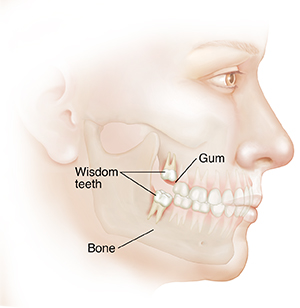Wisdom teeth are very much like your other permanent teeth. The main difference is that they are the last to develop and grow in. They're called wisdom teeth because most people get them at a later age. Most people have 4 wisdom teeth, 1 in each corner of the mouth. But some people don't have any wisdom teeth, or have fewer than 4.
Wisdom teeth and your dental anatomy
There are several types of teeth. Each type is designed for biting or for chewing. The wisdom teeth are chewing teeth (molars). Both the upper and lower jaws have 3 molars on each side. The wisdom teeth are the last in line. This is why they’re called third molars. Many people have wisdom teeth that grow normally. But sometimes, there isn’t enough space for them or they aren't in the right position. Then, your dentist may decide that they may need to be removed. There are 8 other molars to do the chewing. So, most people can get along fine without wisdom teeth.
Anatomy of a tooth
The crown of a molar is the part of the tooth that you can see. It's covered with enamel and has a hard chewing surface. Below the gumline, the root anchors the tooth to the bone. Nerves and blood vessels enter and exit the tooth through the roots.
How wisdom teeth develop
All teeth form in the jawbones. As the roots grow, the tooth’s crown slowly pushes toward the gum until it breaks through the gum (erupts). After a tooth has erupted, the roots keep getting longer. It takes years for the roots to develop fully. The jawbones get more dense and rigid over time.
-
Around age 9. Wisdom teeth start to form inside the jawbones. The jawbones have a lot more growing to do. So they are not yet at their full density.
-
By the late teens. Wisdom teeth roots have developed and are getting longer. The crown of each wisdom tooth may start to erupt.
-
By the early 20s. Each wisdom tooth has erupted or is unable to fully erupt (is impacted). The roots may still be forming. The jawbones have stopped growing.
-
By about age 40. The roots of the wisdom teeth are solidly anchored in the bone. The jawbones have reached their adult density.


